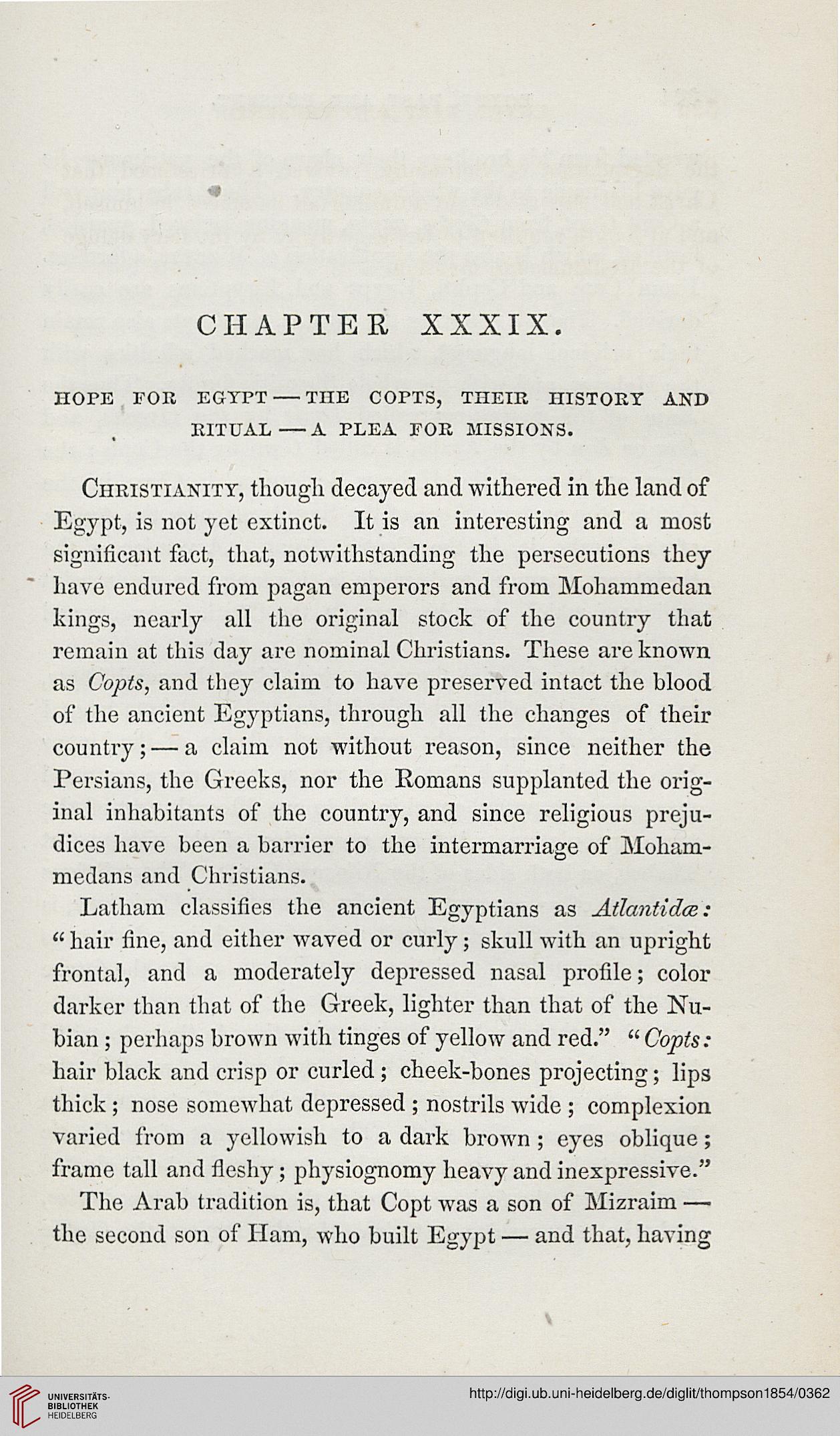•»
CHAPTER XXXIX.
IIOrE FOR EGYPT-THE COPTS, THEIR HISTORY AND
RITUAL—A PLEA FOR MISSIONS.
Christianity, though decayed and withered in the land of
Egypt, is not yet extinct. It is an interesting and a most
significant fact, that, notwithstanding the persecutions they
have endured from pagan emperors and from Mohammedan
kings, nearly all the original stock of the country that
remain at this day are nominal Christians. These are known
as Copts, and they claim to have preserved intact the blood
of the ancient Egyptians, through all the changes of their
country; — a claim not without reason, since neither the
Persians, the Greeks, nor the Romans supplanted the orig-
inal inhabitants of the country, and since religious preju-
dices have been a barrier to the intermarriage of Moham-
medans and Christians.
Latham classifies the ancient Egyptians as Atlantidcz:
" hair fine, and either waved or curly; skull with an upright
frontal, and a moderately depressed nasal profile; color
darker than that of the Greek, lighter than that of the Nu-
bian ; perhaps brown with tinges of yellow and red." " Copts:
hair black and crisp or curled ; cheek-bones projecting; lips
thick ; nose somewhat depressed ; nostrils wide ; complexion
varied from a yellowish to a dark brown ; eyes oblique;
frame tall and fleshy ; physiognomy heavy and inexpressive."
The Arab tradition is, that Copt was a son of Mizraim —
the second son of Ham, who built Egypt — and that, having
CHAPTER XXXIX.
IIOrE FOR EGYPT-THE COPTS, THEIR HISTORY AND
RITUAL—A PLEA FOR MISSIONS.
Christianity, though decayed and withered in the land of
Egypt, is not yet extinct. It is an interesting and a most
significant fact, that, notwithstanding the persecutions they
have endured from pagan emperors and from Mohammedan
kings, nearly all the original stock of the country that
remain at this day are nominal Christians. These are known
as Copts, and they claim to have preserved intact the blood
of the ancient Egyptians, through all the changes of their
country; — a claim not without reason, since neither the
Persians, the Greeks, nor the Romans supplanted the orig-
inal inhabitants of the country, and since religious preju-
dices have been a barrier to the intermarriage of Moham-
medans and Christians.
Latham classifies the ancient Egyptians as Atlantidcz:
" hair fine, and either waved or curly; skull with an upright
frontal, and a moderately depressed nasal profile; color
darker than that of the Greek, lighter than that of the Nu-
bian ; perhaps brown with tinges of yellow and red." " Copts:
hair black and crisp or curled ; cheek-bones projecting; lips
thick ; nose somewhat depressed ; nostrils wide ; complexion
varied from a yellowish to a dark brown ; eyes oblique;
frame tall and fleshy ; physiognomy heavy and inexpressive."
The Arab tradition is, that Copt was a son of Mizraim —
the second son of Ham, who built Egypt — and that, having




